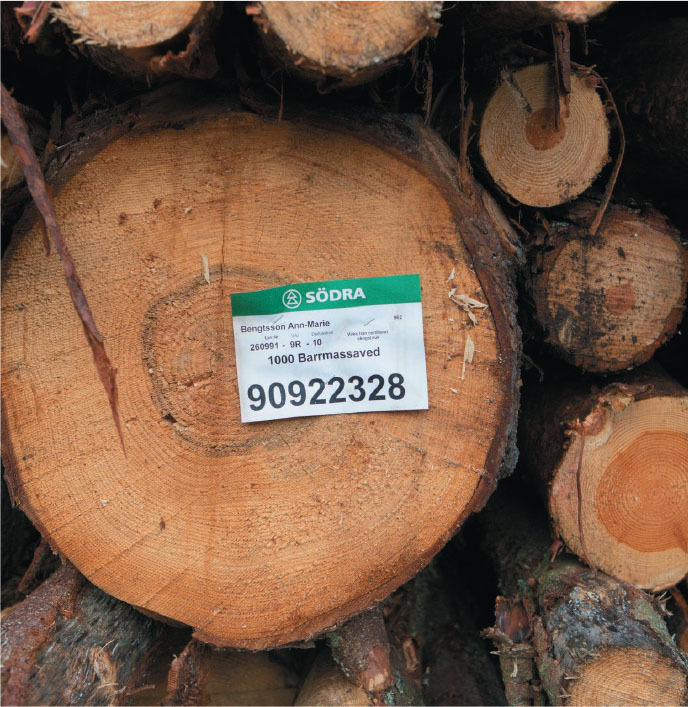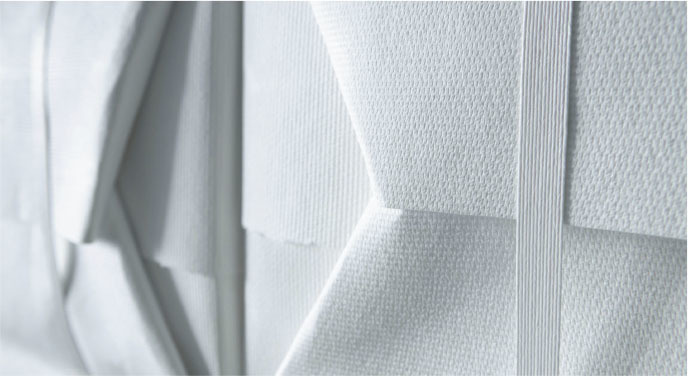 Södra’s raw material comes from the forest estates of its 52,000 members, who also own the Södra group, thus ensuring quality control from seedling to finished product. For every tree harvested from a Södra forest estate, three more are planted.
Södra’s raw material comes from the forest estates of its 52,000 members, who also own the Södra group, thus ensuring quality control from seedling to finished product. For every tree harvested from a Södra forest estate, three more are planted.
Returning to Södra after an absence of 13 years was easy, says the company’s head of Pulp Sales. Having spent five years with Södra as technical product manager from 2004 to 2009, Jens Hallendorf returned in 2022 with a wealth of experience and fresh perspectives from the packaging sector after spending several years with Rottneros and almost 12 years with BillerudKorsnäs focusing on development of the company’s liquid packaging board business.
He left Södra in 2009 to move to the fourth-generation family forest estate his wife had inherited in mid-Sweden. “It was a very different climate to the one we all know today,” he observes. “Advances in technology, accelerated by the pandemic, have made it possible to come back while retaining the family base in Värmland, which wasn’t an option back then,” he says. His time is split between Värmland, the company’s HQ in Växjö, southern Sweden, and being on the road with the sales team visiting customers.
While Hallendorff is not a member of the Södra cooperative, his estate being further north than Södra’s current membership, his situation parallels that of the 52,000 small forest owners who make up the Södra cooperative and together form the largest private landowner in southern Sweden with 2.7 million hectares of forest.
“It’s a business model I’m attracted to for obvious reasons,” he says. “It’s inherently sustainable; family farms being managed to the highest standards so they can be passed on to future generations. Södra’s raison d’être is to add value to its members’ estates. This means providing them with a range of services and support to ensure they grow their forests for the long term, benefiting the members, customers, and the planet.
 The company works to a planting cycle of 70-80 years, so long-term thinking is key. Its foresters are currently planting with a view to mitigating the effects of a warmer Swedish climate in the future.
The company works to a planting cycle of 70-80 years, so long-term thinking is key. Its foresters are currently planting with a view to mitigating the effects of a warmer Swedish climate in the future.
THE LONG VIEW
“The fact that Södra is not a listed company means it is committed to investing in sustainable forestry and forest products for the long term. Its values and commitment to the members and customers remains stable, controlling everything from seedling to finished product. The forest-owning members sell their wood to Södra because they want to, not because they must, which says a lot.
“I’ve worked in companies where the strategy can change every three months, and I know which approach I prefer. Long-term thinking is not to be confused with conservatism or risk aversion. On the contrary. Södra is bold when it comes to investment decisions because it does not need to report to shareholders who expect quick returns. Our members know the planting cycle is 80-90 years. We are currently advising members on optimal planting for a warmer climate, for example. Those investing today will not see the trees they plant harvested—it will be their children and grandchildren seeing the results of their labor.
“As soon as we took on my wife’s family forest estate, we came to realize that as owners we are mere trustees of the land for the generations to come. We cannot bite the hand that feeds us; we are there to grow and nurture the forest for the future and hopefully have a viable commercial business at the same time—one cannot happen without the other.
SUSTAINABILITY AND ECONOMICS: INEXTRICABLY LINKED
“It dawned on me that profit was suddenly somewhat lower on the list of priorities, behind other values such as diversity in the forest. There is profit as an owner just from the sheer joy of walking through a forest in different seasons and feeling overwhelmed by the beauty of this space we are caring for. It makes me happy to harvest berries and mushrooms with my family and occasionally run into a moose or two. Sweden’s ‘right to roam’ law means that our forests are open to everyone. The legacy of the previous custodians of my estate and those of the Södra members is everywhere. Thanks to their sustainable management and long-term vision, we have assets to nurture and pass on to their children.
Södra combines the sustainable management of members’ forests with investment in state-of-the-art facilities to process their wood. Members are incentivized to certify their estates to FSC and PEFC and take measures over and above those required by the law and certifying bodies, aiming for a 20 percent increase in annual forest growth on members’ estates in 2050 compared with 2015.
 Södra offers its forest-owning members a wide range of sustainable forestry services, including the drawing up of an individual Green Plan for each estate.
Södra offers its forest-owning members a wide range of sustainable forestry services, including the drawing up of an individual Green Plan for each estate.
“Modern pulp and sawmills and state-of-the-art technology are of course imperative if we want to stay ahead in this competitive business” Hallendorff remarks, “and both are needed to ensure we remain a supplier of choice in terms of product quality and consistency. Investment is both bold, such as the major rebuild of Värö a few years ago, which led to work to develop a premium-strength agro-enhanced pulp, but also incremental, with small innovations taking place continuously.
“Take the example of FiberSafe. Next year, we plan to double the capacity of what we believe to be the world’s first pulpable bale strap, eliminating the need for bale wires and dewiring stations at papermakers’ mills, and improving health and safety for employees and taking another small step for the most sustainable pulp.”
Södra has chosen to invest in production facilities close to the members’ wood supply so all three pulp mills are in Southern Sweden, optimizing logistics, resource efficiency, and carbon footprint.
A WIN-WIN PULP FOR THE CIRCULAR FUTURE
The ground-breaking project to develop a pulp which will combine wood from Södra’s members with agricultural residue from sources close to the pulp mills is a prime example of resource efficiency being at the top of Södra’s agenda. Following extensive R&D, the pulp has been shown to have the potential to deliver benefits not only in terms of resource efficiency and circularity, but performance. The addition of agricultural residue to softwood pulp will bring significant tensile strength to final sheet properties, especially in the lower refining range. Pending confirmation from the board, the hope is that trial volumes will begin in Q2 of 2024.
SEEING THE WOOD FOR THE TREES
“We recognize that our main market segment, tissue, is especially close to the consumer and issues such as sustainability communication and carbon footprint are high on our customers’ agendas,” Hallendorf says. “We are keen to be seen as a partner, not just a supplier, in the value chain. It’s one of the reasons we are consistently feeding our customer system with data, so that customers can easily use our sustainability information to calculate their own footprint and answer auditing questions, for example.
“On MyPulp+, the suite of online customer services, users can now look up quality and sustainability data with a few clicks with no need to speak to anyone in sales. We’re also adding a water inventory tab to complement our environmental data, origin of wood, carbon footprint and certified volumes, again, helping customers to calculate their own water footprint.
“And, of course, we are committed to the Science-Based Targets initiative (SBTi) and to partnering up with customers to jointly achieve our environmental goals. The great thing about the SBTi is that it gives us all a common vision, one in which we are inextricably interconnected. Our Scope 1 (direct) emissions are our customers’ Scope 2 (indirect) emissions. We need to work together to make a difference for each other and for the future. No company or country can tackle this alone, but together we can.”
 FiberSafe, Södra Cell’s repulpable paper strap, replaces wire straps, increasing operator safety and eliminating the need for a dewiring station. Simply throw the strap into the pulper.
FiberSafe, Södra Cell’s repulpable paper strap, replaces wire straps, increasing operator safety and eliminating the need for a dewiring station. Simply throw the strap into the pulper.
Hallendorff’s experience in the packaging sector was eye-opening in terms of its communication strategies with companies such as Nestlé and Tetrapak having strong and efficient communication that is pushed back down the chain. “I would like to see more of this in the tissue sector,” he says. “If consumers start to push retailers, which is what we need, we can help create thresholds below which quality and sustainability must not fall.
“We’re always keen to go beyond being merely a supplier to being a partner to our customers to help increase awareness of the positives of the industry and help redress misconceptions where they occur.
“Tissue producers are among the most proactive in the business, but we’ve still missed out as an industry on opportunities to communicate the good-news story to the consumer. Södra is too far from the end user for brand recognition on the high street, but it’s in all our interests to join forces and explain to as many people as possible that paper is part of the solution for a more sustainable future.
“Even in countries like Sweden, where we are generally much closer to the forest than many others, the general public can still fail to understand that well-managed forests are a good thing, and that forests are not best left alone. Many don’t realize, for example, that pulp is made from thinnings or the tops of the trees once the log has been sent for timber production. That timber could be making a well-insulated house which will store carbon for generations to come. In the meantime, a whole host of other products from the production processes will help substitute carbon released by fossil-based alternatives. We make everything from green energy and biofuels to climate-smart building solutions, green chemicals, and fertilizer pellets. The idea is to ensure none of the tree is wasted—and none of it is.”
 Paper 360
Paper 360

